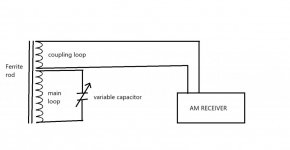I made a loopstick for my AM radio and I used enameled copper wire of 1 mm (approx) thick to make the loops on a ferrite rod of 1 cm thick and 14 cm long. I made the main loop with the number of turns 4x greater than the coupling loop and that gave a combination of 4:1. But is this a 4:1 loop stick or 8:1?
I even tried the combination of 1:1 and 1:2 turns, but none of them work that great.
I also noticed that only a wire greater than 19 (AWG) gives good resonance.
So, I would like to know why the magic is behind using 4:1 and 19 AWG?
I have attached the setup diagram for reference.
I even tried the combination of 1:1 and 1:2 turns, but none of them work that great.
I also noticed that only a wire greater than 19 (AWG) gives good resonance.
So, I would like to know why the magic is behind using 4:1 and 19 AWG?
I have attached the setup diagram for reference.


